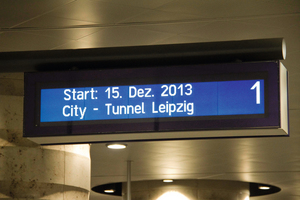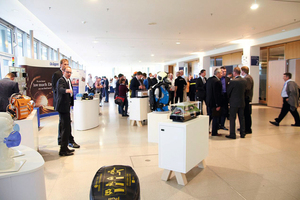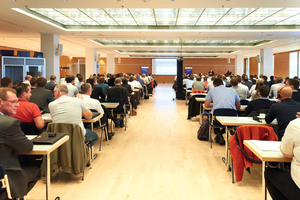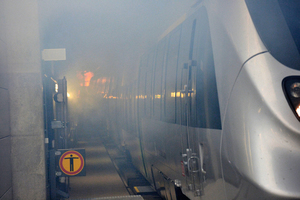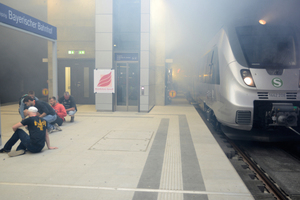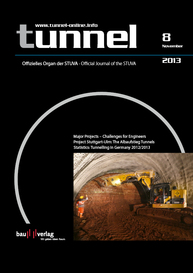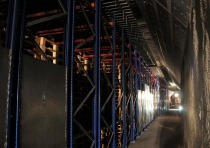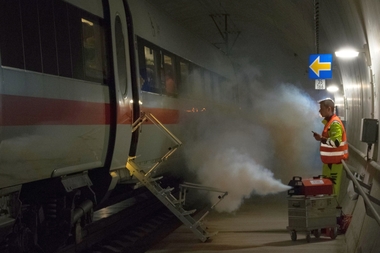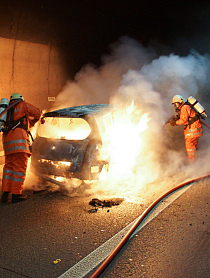5th International Tunnel Forum and Safety Drill for the Leipzig City Tunnel
The City Tunnel beneath downtown Leipzig will shortly be opened (Fig. 1). On the occasion of a full-scale fire protection drill, the Drägerwerk AG & Co. KGaA provided a varied and interesting programme of lectures on tunnel safety on Sept. 4 + 5, 2013 with the 5th International Tunnel Forum for experts from home and abroad (Fig. 2). After a welcoming address by Werner Heitmann from Dräger a wide range of papers was presented in conjunction with the full-scale drill dealing with safety-technical, organizational and structural aspects right up to practical application of the findings and recognitions. This report tackles a number of the aspects that were dealt with.
Eye-Witness Account
Peter Tonner, professor at the Links der Weser Clinic in Bremen and expert for the ICE accident at Eschede gave an impressive account of his experiences in the ICE, which collided with a stray flock of sheep in the Landrücken Tunnel on April 26, 2008 on the journey from Hamburg to Munich. 22 persons were seriously and 17 slightly injured in the incident. The damage caused to the ICE and the rail installations amounted to more than 10 million euros. Tonner reported how he was hurled from his seat to the floor when the whole train began to vibrate. Initially he believed there was fire due to the hail of sparks and dust caused by the train sliding over the superstructure. He thought his last hour had come. The tunnel wall prevented the carriages from overturning. When the train came to a halt most passengers were able to get out of the train. They decided on escaping through the dark tunnel towards the north portal. After walking for about an hour, there they came across the emergency forces still getting their act together. A rescue train, which should basically have been available as soon as possible to assist in keeping with the rescue concept, first arrived at the scene hours later. Peter Tonner has resumed using the ICE but is now far more prepared for unexpected incidents and pays more attention to safety instructions than he used to do.
Human Behaviour – most neglected Factor when an Accident occurs
Yoel Donchin, professor at the Hadassah Medical Center in Jerusalem and responsible for strategy and quality control, revealed how man himself contributes to a catastrophe taking place and how this behaviour can be taken into account for planning to prevent disasters. By means of optical illusions he provided an indication of how quickly man accepts a convenient interpretation. Particularly regarding surprising and completely unexpected sudden changes people tend to subconsciously select, seek and interpret information in such a way that it fulfils their own subjective-positive expectations. This also applies in the event of catastrophes and for emergency services and those working in the control centres. Donchin backed this behaviour up most strikingly by means of video recordings. During the tsunami in Thailand the danger recognized by the observer is initially not recognized at all on account of the apparent calm water surface – evidently those affected first recognize this when the waves smash against the shore providing a reference point for their strength. In the second video sequence, the operating staff at the Chernobyl nuclear power plant show themselves to be similarly surprised when the ensuing catastrophe begins there.
In the event of a catastrophe, the service and emergency staff are often incapable of selecting the correct approach from the mass of information – mainly because they cannot interpret what is actually happening. When control centres are set up, when rescue concepts are devised as well as at the training stage, recognitions relating to the resilience of people – the capacity to survive tricky situation in life without lasting harm – are scarcely taken into consideration. Yoel Donchin recommends automatically restricting the display of operating data and other information in targeted fashion for systems engineering and operating and monitoring installations. He finds that it is of particular importance to provide service and evacuation drills when training the emergency services. Simple toy models enable tricky situations to be understood.
Risk Potential in Transportation Tunnels
Christian Brauner from the Swiss International Fire Academy dealt with the risk potential during tunnel fires. He assessed future developments of tunnel fires and derived consequences for fire fighting and rescue measures. He explained that most fires affected Metro systems, but complained that complete statistics on tunnel fires do not exist. Quite clearly major events, in other words, individual accidents are focused on. Christian Brauner identified the determining factors for the scope of cases of damage, the risk impact, mastering the incident thanks to self-rescue, the conception of escapeways and ventilation as well as tackling the damage. First and foremost, an effort must be made to prevent small fires becoming big ones. Tunnels are not essentially safe, far rather it depends on the correct approach. Tunnel safety can only be attained jointly: starting with design and construction, deficits in communication between those involved – operators, fire brigade, emergency services and communal authorities – and users must be minimized. A lively discussion evolved around the assertions relating to the statistics.
Fire Fighting
Roland Leucker, executive director of STUVA e. V., reported on major fire tests carried out in conjunction with the SOLIT2 project to ascertain the efficacy of water mist fire fighting systems in road tunnels. Liquid and solid matter fires with complete truck loads and fire loads of up to 100 MW were tested. The efficiency of the systems was tested as well as their inter-action with other safety installation in tunnels to identify holistic savings potentials and develop practice-related solutions. Substantially reduced temperatures occurred thanks to the water mist fire fighting system during solid matter fires. In view of the increasing significance of preventive fire protection in tunnels it was also shown that temperatures in the concrete shell are also considerably reduced thanks to these systems and that the damage to the tunnel can be substantially diminished given adequate concrete covering. It was confirmed during the ensuing discussion that in Germany little attention is paid to structural protection during safety planning whereas internationally it is accorded great importance especially when toll tunnels are involved. There are alternatives to using water mist to combat fires such as water vapour, deluge system and foam. However, so far not enough accessible findings have been published on them.
Anton Gögele, CEO of the Italian Securplan GmbH revealed new methods in fighting tunnel fires in theory and practice by presenting the Top Turbine. Based on experience gained from spectacular events and extensive fire tests in Norway, he traced a pattern from the principles of fire development by way of temperature development and types of ventilation to the extinguishing turbines devised by his company. Thanks to the extinguishing turbine water mist with added foam is created by means of which a so-called pool fire with a load of 350 MW can be brought under control within 25 s. Normally discharge widths of 50 m are attained.
Safety and Rescue Concept – not simply for the City Tunnel
Hans-Peter Vetsch was quoted by MDR-Radio for saying that tunnels should not be demonized: “the tunnel is safer than the open route. There are no outside influences, there are no avalanches, there are no foreign bodies coming from the side. The tunnel as such is safer. The sole problem of the tunnel is its surroundings. You are enclosed”. Hans-Peter Vetsch is head of operations at the new Gotthard Base Tunnel, the world’s longest rail tunnel – with a length of 57 km. The safety concept, based on 2 bores, which alternately serve as evacuation tunnels, was hotly contested for a long time among the general public. Hans-Peter Vetsch points to the opinion formed by people as a result of the influence of the media as a remarkable aspect, which also influenced safety concepts. As far as he is concerned preventing incidents happening is the main thing. He suggested that the proportionality of measures should be considered in order to prevent massive costs being involved to minimally reduce the probability of an incident taking place whereas considerably more safety can be secured with the money elsewhere. Frequently a substantial discrepancy exists between technical requirements and political demands.
Cross-passages between parallel tunnel bores are part of the escapeways in lengthy transportation tunnels. Robert Galler, professor at the Montan University at Leoben/A dealt with the suitable lengths in between and revealed on the basis of project examples such as the Gotthard and Ceneri base tunnels as well as the Channel Tunnel that confusion prevails as far as guidelines in Europe are concerned. An effort should be made to arrive at a standard length of say, 500 m on account of the considerable importance for the construction and operating costs of tunnels.
Klaus-Jürgen Bieger, responsible for fire protection at the Deutsche Bahn AG examined safety aspects in conjunction with “Stuttgart 21” and identified a 4-phase concept starting with planning the structure by way of tunnelling and operation right up to an incident occurring. Architects are advised to include fire protection in the planning, as frequently this can only be accomplished uneconomically with difficulty. The preventive measures include reducing the probability factor of an incident by deciding on 2 single-track tunnel bores. In addition, the safety concept calls for high demands on fire protection in the vehicles themselves. Additional measures are designed to make sure that a train does not get stuck in the tunnel. Great attention must be accorded self-rescue and third-party rescue, in which connection Klaus-Jürgen Bieger admitted that self-rescue called for civil courage. Short and in particular wide escapeways have been set up to improve self-rescue. With regard to third-party rescue the opportunity to deploy fire service vehicles and even busses is created. In contrast to what has been standard practice in rail tunnels in the past, smoke will be removed on a natural basis should a vehicle catch fire, which will be supported by additional installations for removing smoke in the structures between the station and the tunnel bores. The smoke-proof doors at the cross-passages and the access gates are problematic owing to the extremely high strains caused by pressure and suction.
Christian Sommerlechner, ÖBB Infrastuktur AG looked at the problem of safety in long tunnel sections taking the example of the Austrian tunnel from Vienna to St. Pölten. It is really essential to take safety aspects into consideration from the beginning and establish proper communication between all those involved. Christian Sommerlechner heaped praise on the commitment of those involved. His own findings have revealed that self-analysis as well as timely and regular training is essential.
Karl-Heinz Schneider, who heads the Leipzig Municipal Fire Brigade, presented fire-protection and technical measures for countering dangers in the City Tunnel. The main fire station is responsible for planning and controlling assignments and civil protection as well as response assignments and also for preventive fire and hazard protection as well as the procurement of technical equipment and vehicles. It acts as the fire service and rescue control centre and takes over emergency services providing a rescue and transport vehicle with 12-hour availability. The main fire station has a staff of 47 available for fire protection and a further 44 for technical emergency services. The City Tunnel is fitted with extensive safety installations. The underground stations have an automatic fire fighting system at their disposal and the tunnel possesses a combination of a natural smoke removal system and a mechanised one. The control and safety technology in the tunnel complies with the standard prevailing through the country; the Leipzig control centre is responsible for running the trains. Video monitoring with a control function through members of staff of the permanently manned “3-S Centre” (Safety, Cleanliness and Service) is installed at all underground station areas. There are 2 fire-resistant evacuation stairway areas separated from the tunnel and the stations, which are marked by means of rescue sign lighting. The fire protection and operating concept for the trains embraces 4 safety levels. An emergency brake bypass system is intended to ensure that a train in the tunnel moves on to the next possible evacuation area outside the tunnel in the event of fire.
Summary
The participants (Fig. 3) certainly profited from the informative, 2-day 5th International Tunnel Forum. The cleverly combined series of lectures spanning various disciplines provided those taking part with information for their own fields of activity while at the same time enabling them a view beyond the horizon.

